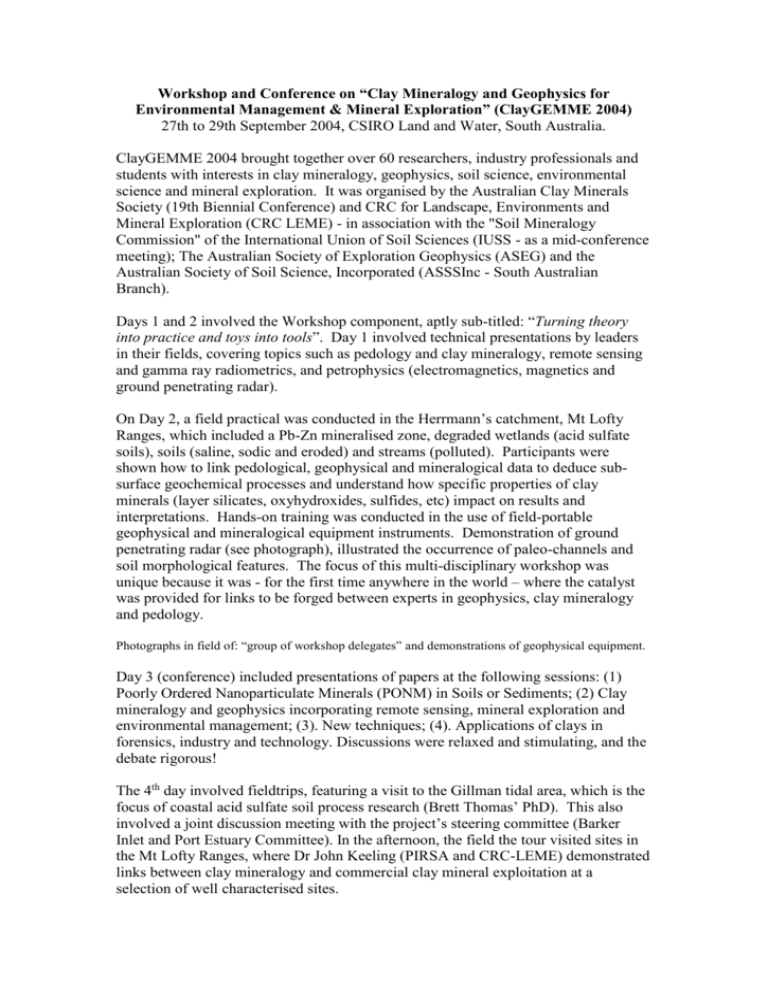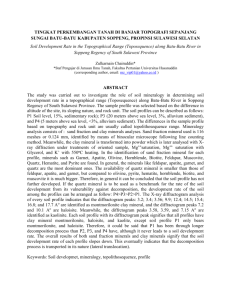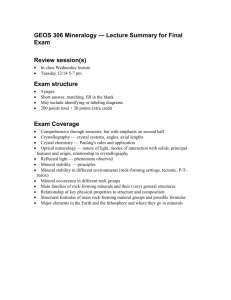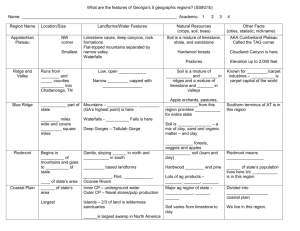Workshop and Conference on “Clay Mineralogy and Geophysics for
advertisement

Workshop and Conference on “Clay Mineralogy and Geophysics for Environmental Management & Mineral Exploration” (ClayGEMME 2004) 27th to 29th September 2004, CSIRO Land and Water, South Australia. ClayGEMME 2004 brought together over 60 researchers, industry professionals and students with interests in clay mineralogy, geophysics, soil science, environmental science and mineral exploration. It was organised by the Australian Clay Minerals Society (19th Biennial Conference) and CRC for Landscape, Environments and Mineral Exploration (CRC LEME) - in association with the "Soil Mineralogy Commission" of the International Union of Soil Sciences (IUSS - as a mid-conference meeting); The Australian Society of Exploration Geophysics (ASEG) and the Australian Society of Soil Science, Incorporated (ASSSInc - South Australian Branch). Days 1 and 2 involved the Workshop component, aptly sub-titled: “Turning theory into practice and toys into tools”. Day 1 involved technical presentations by leaders in their fields, covering topics such as pedology and clay mineralogy, remote sensing and gamma ray radiometrics, and petrophysics (electromagnetics, magnetics and ground penetrating radar). On Day 2, a field practical was conducted in the Herrmann’s catchment, Mt Lofty Ranges, which included a Pb-Zn mineralised zone, degraded wetlands (acid sulfate soils), soils (saline, sodic and eroded) and streams (polluted). Participants were shown how to link pedological, geophysical and mineralogical data to deduce subsurface geochemical processes and understand how specific properties of clay minerals (layer silicates, oxyhydroxides, sulfides, etc) impact on results and interpretations. Hands-on training was conducted in the use of field-portable geophysical and mineralogical equipment instruments. Demonstration of ground penetrating radar (see photograph), illustrated the occurrence of paleo-channels and soil morphological features. The focus of this multi-disciplinary workshop was unique because it was - for the first time anywhere in the world – where the catalyst was provided for links to be forged between experts in geophysics, clay mineralogy and pedology. Photographs in field of: “group of workshop delegates” and demonstrations of geophysical equipment. Day 3 (conference) included presentations of papers at the following sessions: (1) Poorly Ordered Nanoparticulate Minerals (PONM) in Soils or Sediments; (2) Clay mineralogy and geophysics incorporating remote sensing, mineral exploration and environmental management; (3). New techniques; (4). Applications of clays in forensics, industry and technology. Discussions were relaxed and stimulating, and the debate rigorous! The 4th day involved fieldtrips, featuring a visit to the Gillman tidal area, which is the focus of coastal acid sulfate soil process research (Brett Thomas’ PhD). This also involved a joint discussion meeting with the project’s steering committee (Barker Inlet and Port Estuary Committee). In the afternoon, the field the tour visited sites in the Mt Lofty Ranges, where Dr John Keeling (PIRSA and CRC-LEME) demonstrated links between clay mineralogy and commercial clay mineral exploitation at a selection of well characterised sites. ClayGEMME 2004 drew on the unique expertise that is being developed and spearheaded in CRC LEME and CSIRO Land and Water under the joint guidance of Drs Rob Fitzpatrick (pedology and clay mineralogy) and Graham Heinson (geophysics) in the emerging field of “soil and forensic/mineral exploration geophysics”. This workshop and meeting has now given us some very "good leads and ideas" for the two IUSS symposia in 2006 Prepared by Rob Fitzpatrick Source: International Union of Soil Sciences (IUSS) Bulletin No. 105 2004; p. 47. (modified) Appendix 2 Inland Project Objectives To develop innovative approaches and methodologies for constructing mechanistic models of soil-landscape evolution for inland sulfidic environments, including inland acid sulfate soil (ASS) and groundwater systems across Australia. To apply this information to derive pedo-regolith transfer functions to help spatially model and predict soil-water landscape properties at 30 pilot regions/ catchments across Australia (3-8 pilot studies per State) with implications for infrastructure and NRM planning, water quality management and mineral exploration. To apply this information to publish an Atlas of inland ASS in Australia, which includes: (i) a national map of inland ASS with common legend that incorporates risk assessment criteria and correlations between Australian and International Soil Classification Systems, (ii) database of representative soil-regolith case studies from pilot regions around Australia and (iii) web-based product geo-referenced with other ASRIS products. Scope of Work Create a project framework under which integrated outcomes will be delivered to develop a national understanding of the spatial distribution and process of Inland ASS and related hydrology in Australian regolith by undertaking the following three sub-projects: (i) Spatial distribution and processes of Inland ASS and acidic groundwaters, (ii) Geochemistry, isotope geochemistry and mineralogy, (iii) Biomineralisation and microbial biochemistry.






